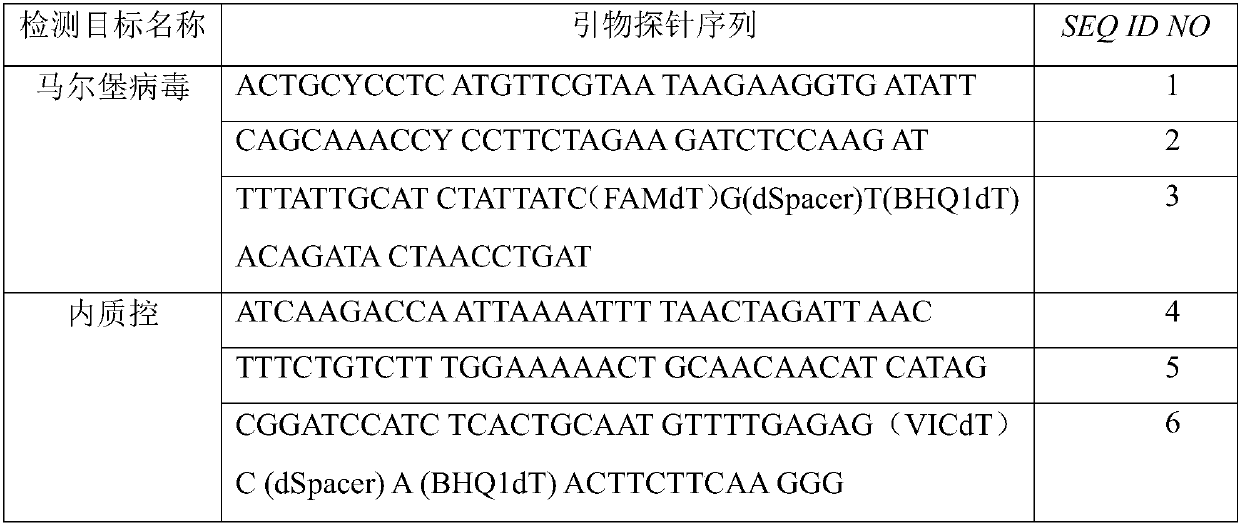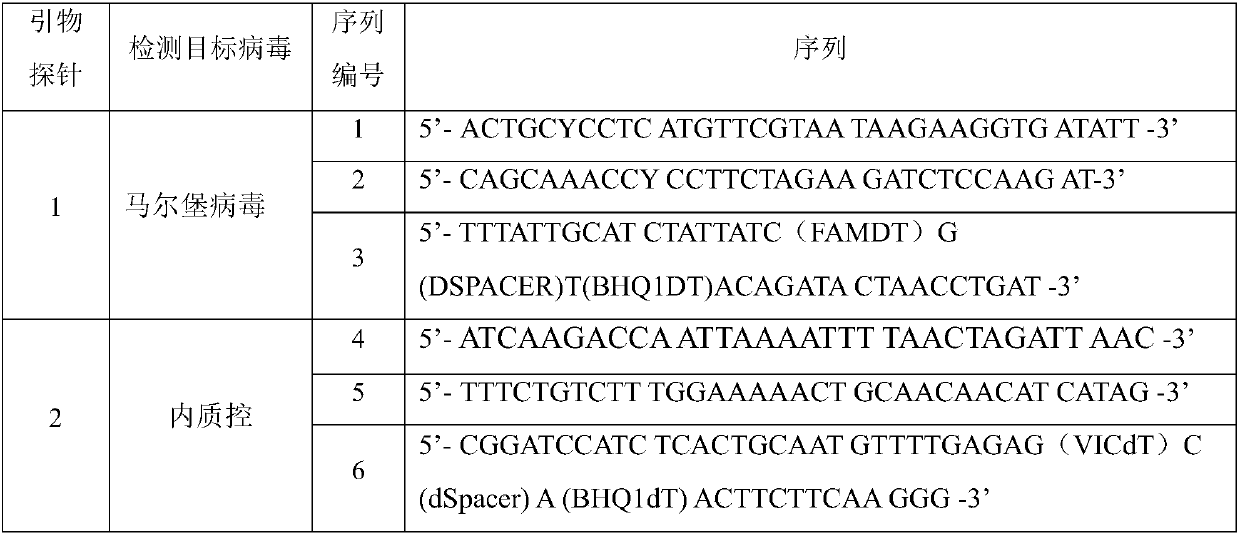Marburg virus detection primer, probe and kit
A Marburg virus, primer-probe technology, applied in biochemical equipment and methods, microbial determination/inspection, DNA/RNA fragments, etc., can solve problems such as inability to detect Marburg virus sensitively and specifically, and reduce labor costs. and time cost effect
- Summary
- Abstract
- Description
- Claims
- Application Information
AI Technical Summary
Problems solved by technology
Method used
Image
Examples
Embodiment 1
[0052] The synthesis of embodiment 1 primer and probe
[0053] A reagent company was commissioned to synthesize the primer-probe sets shown in Table 2.
[0054] Table 2
[0055]
[0056] The nucleotide sequences of the upstream and downstream primers and probes for detecting Marburg virus are respectively shown in SEQ ID NO.1, SEQ ID NO.2, and SEQ ID NO.3.
[0057] In the nucleotide sequence shown in SEQ ID NO.3, the 19th base from the 5' end is labeled with a FAM luminescent group, the 20th base is connected with an abasic site, and the 22nd base is labeled with a quencher Killing group BHQ1.
[0058] The nucleotide sequences of the upstream and downstream primers and probes for detecting the internal quality control are respectively shown in SEQ ID NO.4, SEQ ID NO.5, and SEQ ID NO.6.
[0059] In the nucleotide sequence shown in SEQ ID NO.6, the 31st base from the 5' end is marked with a VIC luminescent group, the 32nd base is connected with an abasic site, and the 34th...
Embodiment 2
[0060] Example 2 specificity verification
[0061] The Marburg virus-specific primer pair and probe designed in Example 1 were evaluated and verified, mainly evaluating specificity, minimum detection limit and coverage.
[0062] Specificity evaluation: Select in vitro transcription of Hantaan virus, Seoul virus, Andes virus, Sindbis virus, dengue virus, Ebola virus, Lassa virus nucleic acid as the specificity evaluation nucleic acid. The total nucleic acid concentration of each sample was 0.001 ng / μL, and the nucleic acid of each sample was mixed as a template for specificity evaluation, and RPA amplification was performed.
[0063] Preparation of RPA reaction system: 50 μL of total system, 29.5 μL of rehydration buffer, 2.5 μL of magnesium acetate solution (280 mmol / L), primer 2 μL (10 μM) each, 0.5 μL (10 μM) probe, 1 μL reverse transcriptase (200 U / μL), 5 μL template, and make up the rest with water.
[0064] The reaction conditions of the RPA reaction: FAM was selected a...
Embodiment 3
[0067] Embodiment 3 minimum detection limit verification
[0068] Evaluation of the minimum detection limit: the standard plasmid with the recombinant Marburg virus gene sequence was cut with restriction enzymes SpeI and PvuII, linearized and transcribed in vitro; the initial concentration was selected as 10 5 copy / μL transcript, which was serially diluted to 10 4 copies / μL, 10 3 copies / μL, 10 2 copies / μL, 10 copies / μL, 2 copies / μL and 1 copy / μL. System preparation and RPA reaction conditions are the same as those in Example 2 for specificity evaluation. In the reaction system, the concentration of the virus was 5×10 4 copy / system, 5×10 3 copy / system, 5×10 2 copies / system, 50 copies / system, 10 copies / μL and 5 copies / system.
[0069] Judgment of RPA reaction results: blank control and negative control are established, otherwise the experimental results will be invalid; if the FAM channel has an amplification curve, the primer pair of SEQ ID NO.1-2 and the probe of SEQ ID...
PUM
 Login to View More
Login to View More Abstract
Description
Claims
Application Information
 Login to View More
Login to View More - R&D
- Intellectual Property
- Life Sciences
- Materials
- Tech Scout
- Unparalleled Data Quality
- Higher Quality Content
- 60% Fewer Hallucinations
Browse by: Latest US Patents, China's latest patents, Technical Efficacy Thesaurus, Application Domain, Technology Topic, Popular Technical Reports.
© 2025 PatSnap. All rights reserved.Legal|Privacy policy|Modern Slavery Act Transparency Statement|Sitemap|About US| Contact US: help@patsnap.com



